
00:56
Hong Kong Science Museum chief on preparing for Big Eight dinosaur exhibition
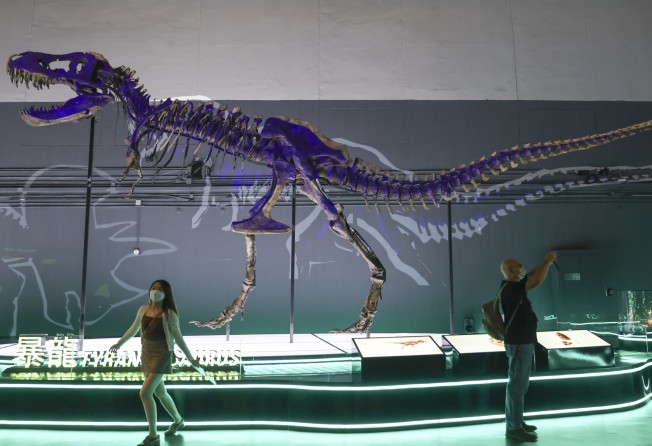
When visitors step into “The Big Eight – Dinosaur Revelation” exhibition at the Hong Kong Science Museum, they will be greeted with a clear, but maybe surprising, message:
“Do not choose extinction.”
Paulina Chan, director of the museum, says: “The earth has experienced a number of mass extinction events because of changes to the environment. We are facing the same challenges caused by climate change.
“We have serious global warming, we have extreme weather conditions, we are losing our biodiversity. All of this information is telling us that we are facing the same fate as the dinosaurs.”
Chan says the museum will subtly drive the message home during the exhibition, which opened to the public on July 8 and runs through November 16.
“We need to think about if someday humans will be extinct, and we are at a critical juncture. We need immediate action to save our earth, to try and sustain our environment,” she says.
In 2016, scientists found that the asteroid impact off the Yucatán Peninsula – the leading theory as to what killed 75 per cent of life on Earth 66 million years ago – created two major global warming spikes, exacerbating the extinction.
Nils Knötschke, a world-renowned dinosaur preparator and former scientific director of the Dinopark open-air dinosaur museum in Münchehagen, Germany adds that we have a misconception that dinosaurs were unable to cope with extreme climate change and died off as a result.
While many species certainly did die, a large chunk of them still exist, such as alligators and sharks, and dinosaurs themselves evolved into birds.
“They are inventive and adaptable animals because they never truly became extinct. The evolution of dinosaurs shows us you have to be adaptable,” Knötschke says.
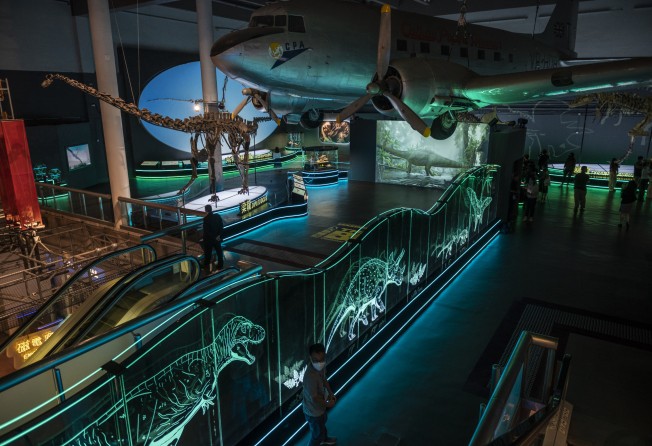
He adds that we must understand the past to create a brighter future, and that the dinosaurs are an example of what could happen as the globe heats up.
“I think humans are not [self-reflective], we just continue, continue, continue – but there will be a moment when, suddenly, there is no continue any more,” he says.
The dinosaurs come from various countries and include an Allosaurus, Diplodocus, Hatzegopteryx, Hesperosaurus, Triceratops, Tyrannosaurus rex, Spinosaurus and a baby sauropod.
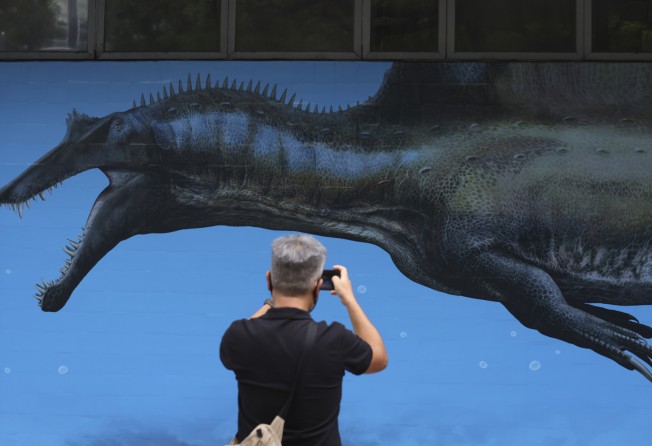
“The most controversial of all of these is the Spinosaurus,” says Knötschke, gesturing towards a gigantic semi-aquatic dinosaur that dominates an entire wall of the room.
“The debate is if it can dive with that large scale on its back. It is a unique dinosaur.”
The Allosaurus, named “Big Al 2”, is made of 99 per cent real bones, with only the tip of the tail being a model. The creature looks similar to the Tyrannosaurus rex, also on display, but it lived during the Jurassic Period, while the T. rex lived in the Cretaceous period.
Photos do not do justice to how terrifying the Hatzegopteryx fossil is. With a wingspan larger than many shops in Hong Kong, the thought of this pterosaur flying in the skies and hunting its prey is enough to send shivers up one’s back. Pterodactyls are the most famous of this genus of flying prehistoric creatures, which are not dinosaurs.
“It’s like you landed the Mona Lisa from the Louvre when you go to Romania and say we need some of your Hatzegopteryx bones,” says Knötschke.
The Triceratops – a three-horned herbivore that is one of the most popular dinosaurs – was the most challenging specimen to mount, according to Knötschke.
It was constructed for the first time for the exhibit and the sacrum weighs around 200kg (440lbs), the tibia is 150kg and the femur is 80kg.
“We accidentally found the lower jaw of the Triceratops during the preparation. It was not listed on the map or fossil list from the excavation,” he says.
The jaw bone was a particularly interesting discovery because skull fossils are quite rare, as they are more likely to have disintegrated over the more than 80 million years since the animal died.
Fans of the Stegosaurus will enjoy looking at the Hesperosaurus fossils, which feature the same finned shells that line the back, despite being of a different genus.
It’s not a leap to imagine the ground shaking when thinking about the Diplodocus, a massive sauropod, taking its mighty steps. Finally, a baby sauropod offers a window into the lives of younglings.
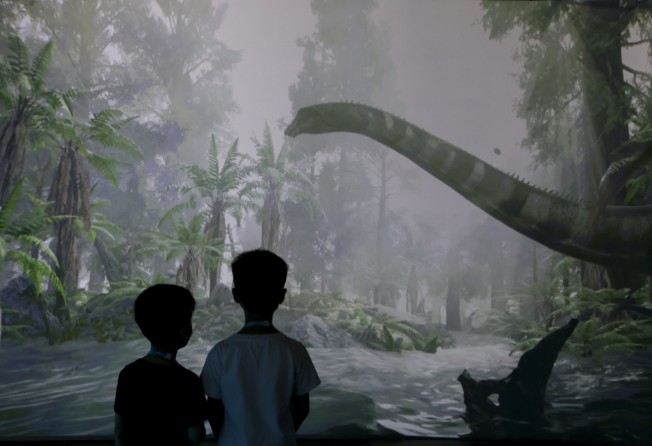
The fact that this event at the Hong Kong Science Museum is even happening is a testament to perseverance through unpredictable times, most notably the Covid-19 pandemic and all of the hurdles it brought with it.
The word “challenge” was the common theme from organisers when they were asked about getting the bones to Hong Kong.
“When I sink my teeth into something, I will not let go, and, with [fellow organiser Christoph Keilmann], we are like-minded people,” says Michelle Ong, the founder of the First Initiative Foundation, a co-organiser of the event along with the museum.
Asked if there was ever a chance this exhibition would not happen, Ong says: “No. That was not an option. Sometimes we had to take some gambles, but I said, ‘Look, we will continue and we will find a way.’”
The Allosaurus, for example, comes from Wyoming, in the US, and the Hatzegopteryx is from Romania. Other specimens come from Germany, Switzerland, Italy, the Netherlands and Morocco.
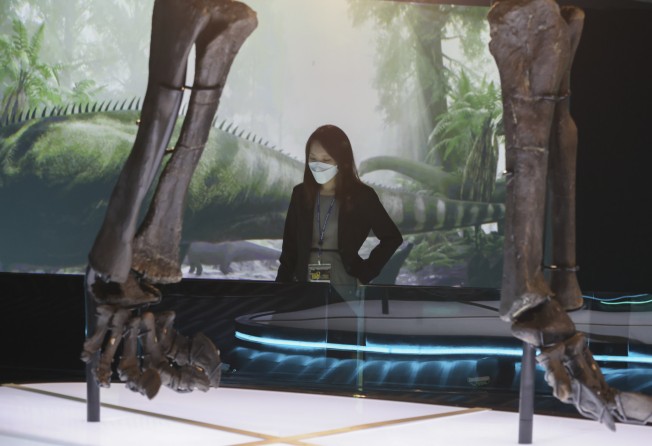
Convincing their owners to loan what were often described as “their babies” required a significant level of trust.
“I work for a big dinosaur museum and we have good contacts,” Knötschke says. “So we contacted our colleagues and said, ‘We have this big project in Hong Kong, would you give us your precious originals for this exhibition?’ Which, you can imagine, is quite hard to do.”
Not only does it take careful coordination to ensure all of these bones arrive safely, but the people in charge of transporting, preparing and building the dinosaurs also had to add Hong Kong’s seven-day quarantine to their list of hurdles.
This meant much of the event was planned via online meetings, and the workers from outside Hong Kong never performed site visits, meaning they were stepping into the exhibition room for the first time when preparing everything for the public opening.
As the event started to become realistic amid Covid-19 restrictions, Russia invaded Ukraine, and suddenly it was dramatically more expensive to ship the fossils to Hong Kong.
“There were a million things that were not ideal, but we got through it,” says Amanda Cheung, managing director of the First Initiative Foundation. “In the end, we were very focused on getting the results.”
Amanda Cheung on hoping the exhibition inspires a new generation:
The exhibition’s organisers want the event to be a celebration, a moment of joy for a city that has gone through a rocky three-year stretch of its history.
“We want to bring a joyful experience to visitors, and we decided to make the exhibition free for everyone. This is totally free,” Chan says. “We want to open the door to all the people and their smiling faces.”
And while Chan and her fellow organisers hope the adults enjoy the exhibition, it’s hard to ignore that this is a particularly valuable event for children, who are famously obsessed with dinosaurs and (in many cases) have endured years of online classes, school closures and cancelled recreational activities due to Covid-19.
“If we do not achieve anything else, at least we want to give a little joy to the kids, to the parents,” Ong says.

It’s hard not to imagine children walking into the exhibition room and hearing the roar of the Tyrannosaurus rex while picturing swimming with the intimidating Spinosaurus, or getting transfixed on the sheer size of the Diplodocus.
Then, it’s even easier to picture their parents taking pleasure in the joy and enthusiasm that is unique to children.
“The Big Eight – Dinosaur Revelation”, Hong Kong Science Museum, until November 16. Admission is free but reservations need to be made up to seven days in advance through an e-booking system. Inquiries: 2732 3232.